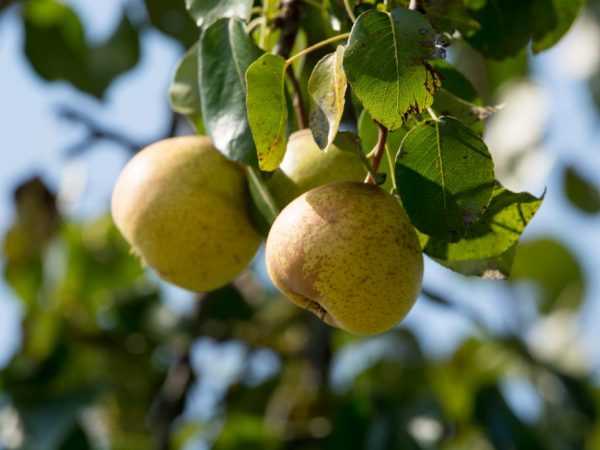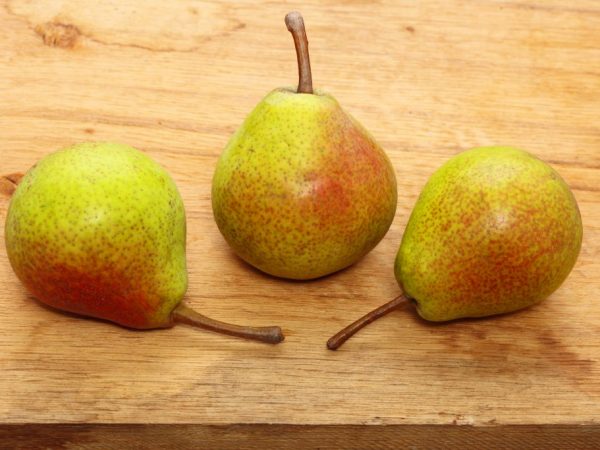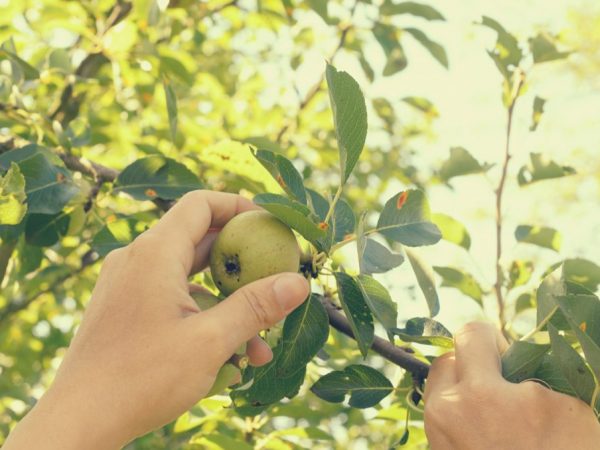Description of Krasulia pear
pear Krasulya is a hybrid that was bred at the research institute in the city of Chelyabinsk. The authorship belongs to E. Falkenberg. The main purpose of the variety is to grow it in Siberia and the Urals.

Description of Krasulia pear
Characteristics of the variety
Krasulia is a summer pear that fully ripens in early August. This early maturity is associated with the short summer in the growing region and helps the tree to give good yields even in such conditions. The fruits are harvested when almost the entire surface is covered with a blush, and the base color becomes slightly golden.
A young tree bears fruit for the first time in the fourth or fifth year of life. Plants begin to bloom in mid-May. The hybrid is self-infertile, therefore it needs pollinators, the best among which are the Rainbow and Severyanka pears.
The fruits have excellent taste, but they are stored for a short time (10-15 days). They are used to prepare blanks for the winter, add to desserts, baked goods, make marmalade and boil compotes, and also eat them raw.
A distinctive feature is the high winter hardiness of Krasuli, which increases from the moment of the first fruiting. It is grown not only in summer cottages, but also in industrial enterprises, since the variety has high transportability.
Description of the plant
Plants of medium size and dimensions up to 5 m high. Crown shape - spherical, spreading, but rather compact. A distinctive feature of the hybrid is the thorns on the branches.
The bark has a greenish tint, peels off, on young shoots - brown with villi. Leaves are bright green, small but thick. They are round and rather wide in shape, slightly curved.
The bloom is profuse and fragrant. Large flowers are collected in inflorescences of 3-8 pieces.
Description of fruits
The hybrid got its name precisely because of its beautiful fruits. Small pears: the weight does not exceed 120 grams, almost the same. They have a rounded, slightly flattened shape.

Fruits are round in shape, weight does not exceed 120 g
The surface of the fruit is smooth and shiny, buttery. At the stage of maturity, it has a green color, which, as it fully ripens, is replaced by a golden green with a violet-red blush. The subcutaneous points are clearly visible.
The pulp is very tasty, beige with a creamy shade. It is loose and juicy and, at the same time, tender and oily. The aroma is not very pronounced.
Landing
Spring is considered optimal for planting. You should choose a site that is well warmed by the sun, protected from drafts and strong winds. The soil on it should be loose and highly fertile, and underground waters are located below 2.5 m from the surface.
The landing pit has been prepared since the fall. The standard size is 70-80 cm in diameter and at least 70 cm in depth. Before planting, it is worth checking the seedling well for any damage, and also drive in a peg at a distance of 30 cm from the center of the hole, which will be 50-60 cm above ground level.
A mixture of humus, topsoil, sand and fertilizers is poured into the planting pit so that a small mound forms. A seedling is placed on it and covered with fertile soil.
It is important to ensure that the root collar remains a few centimeters above the surface. The soil around the tree is well compacted, the trunk is tied to a peg. The seedling must be watered: for this, a hole is made around it, into which about 3-4 liters of water are poured, after which the soil is mulched.
Care
Leaving is reduced to standard procedures.
Watering
A young plant must be watered regularly. Abundant watering is also necessary during the period from the beginning of flowering to full ripening of the fruit.
The rest of the time they can be reduced a little. Depending on weather conditions and soil conditions, water it two to four times a month. It is necessary to water the plants in the hole around the trunk, but not under the trunk itself.
Top dressing
The description of the variety suggests that the first feeding should be carried out no earlier than in the second year of life. In the future, you can use both mineral fertilizers and organic matter. The last feeding is used every three years. Nitrogen-containing fertilizers are applied to the soil annually, preferably in spring. Potash and phosphorus are used in summer.
Pruning trees
The first pruning can be done immediately after planting. The first few years it is carried out in order to form a good crown, later - sanitary, even later - rejuvenating. After pruning, all areas are smeared with garden varnish.

Care involves watering, feeding, pruning trees and loosening the soil
Loosening the soil
It is a necessary stage of maintenance, since it allows air and water to penetrate well into the ground. It is also necessary to regularly remove weeds from the site. This will help protect the plant from many diseases and pests.
Preparing for winter
First of all, it consists in mulching the trunk circle to protect the tree from freezing. It is recommended to additionally cover young trees every winter, adults only if the winter is snowless and very cold.
Diseases and pests
The description suggests that this variety is highly resistant to major diseases such as scab and fire blight, gall mite and bacterial cancer. But still, there are diseases that can affect him.
- Powdery mildew. As a preventive measure, plants are annually treated in spring with a solution of colloidal sulfur (2-3 times), in autumn - with Bordeaux liquid. Special chemicals are used for treatment.
- Fruit rot. For prevention, copper sulfate is used (in spring and after flowering) and urea solution (in autumn).
Among insect pests, the most common are:
- mothball;
- leaf roll;
- copperhead.
For prevention, trees are fumigated with tobacco smoke, treated with tobacco infusion. Insecticides help fight pests.
Conclusion
Summer pear Krasulia needs regular complex care, ensuring that you will get an excellent return in the form of a bountiful harvest and excellent quality fruits.


